Share:
Hello all!
This month, let's go back to the basics and look at the different types of manual wheelchairs available. As I have written in a previous Clinical Corner article, funding agencies for mobility devices vary province by province in Canada and each agency has different criteria on who is eligible to receive a manual wheelchair and which type or category of manual wheelchair can be considered for a qualified individual. Each province also has its own classification terms. For example, a particular model of a manual wheelchair may be in a certain category in one province and a different category in another province. This month's article will look at generic classification of manual wheelchairs at an introductory level. The categories of manual wheelchairs include transport, standard, folding, rigid, and dynamic tilt. Let's take a look at each one.
Transport Wheelchair
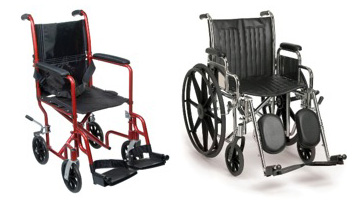
A transport wheelchair may be used by an individual who does not require a manual wheelchair on a daily basis. Typically, these types of wheelchairs are used to "transport" a person from one location to another when a person is unable to walk the required distance; for example, from a parked car to a doctor's office. The people using these types of wheelchairs tend to be dependent for propulsion; that is, another person pushes the wheelchair for the person who is sitting in it.
As the pictures above illustrate, transport wheelchairs have minimal available adjustments. This is why they are not ideal for someone who will be self-propelling. In addition, the lack of adjustability means that a transport wheelchair is not appropriate for someone who requires positioning in a wheelchair. Although there are limitations to transport wheelchairs, a transport wheelchair serves the purpose of helping a person move from one point to another.
Standard Wheelchair
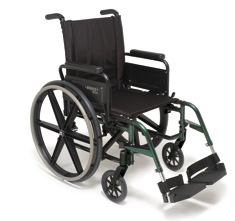
A standard wheelchair has more adjustability than a transport wheelchair. The arm rests are height adjustable to allow proper positioning of the upper extremities. The foot rests are height adjustable to properly position the lower extremities. In addition, there is some adjustability in the rear wheel position. This allows for a change in the seat-to-floor height, which can be important for transfers, foot propulsion, and access to the environment. The ability to move the position of the rear wheel vertically also allows for a change in the seat angle to produce a fixed tilt on the wheelchair, which can aid in positioning and may assist with rear wheel access for upper extremity propulsion.
Folding Wheelchair
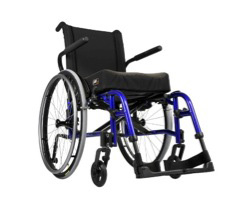
An adjustable folding wheelchair is lighter in weight than a standard wheelchair. It also has more options available in terms of configuration than a standard wheelchair. This means that there are more choices available, including types of wheels, tires, casters, arm rests, wheel locks. (Future Clinical Corner articles will address configuration of a wheelchair – the choices made with respect to all options – and the impact this may have on a person's ability to propel a manual wheelchair as efficiently as possible.)
One of the key features that differentiates an adjustable folding wheelchair from a standard wheelchair is the ability to modify the placement of the rear wheel. In a folding wheelchair, the rear wheel can be adjusted both vertically and horizontally. Adjustment of the rear wheel horizontally is required for centre of gravity adjustment. In addition, the degree of camber, or angle, of the rear wheel, and the lateral position of the rear wheel can be adjusted in a folding wheelchair. (Future articles of Clinical Corner will address centre of gravity adjustability, camber, and lateral position and why these are important considerations when prescribing manual wheelchairs for individuals.)
The cross-brace on both a standard wheelchair and a folding wheelchair allow for easy folding and transportation of these wheelchairs, as the pictures below illustrate.
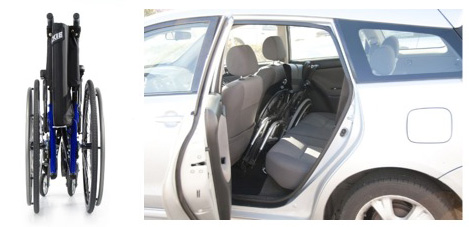
Rigid Wheelchair
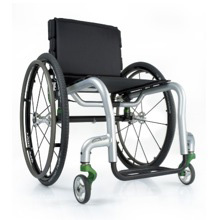
A rigid wheelchair is lighter in weight than a folding wheelchair. As the above picture illustrates, a rigid wheelchair does not have a cross-brace, which helps to reduce the overall weight of this type of wheelchair. Some rigid wheelchair models can fold; however, the fold occurs at the back canes of the wheelchair, with the back folding down to the seat, creating a "box" shape to lift into/out of a vehicle after the easy removal of the rear wheels.
The placement of the rear wheels of a rigid wheelchair can be modified through the position of the camber tube to adjust centre of gravity, rear seat-to-floor height, camber and lateral access for an individual. Optimal positioning of the rear wheel for an individual enables efficient propulsion.
In addition, rigidity in a wheelchair decreases flex in the frame of the chair. The ideal is that all of the energy of propulsion applied to the handrims on the rear wheel is translated into movement as any frame flex is lost movement. The more rigid the wheelchair, the easier it will be to propel it. In addition, the lighter the wheelchair, the easier it will be to propel it, assuming optimal set-up.
Dynamic Tilt Wheelchair
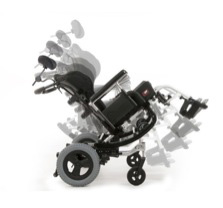
Dynamic tilt, or tilt-in-space, wheelchairs have a mechanism by which the angle of the seat pan relative to the floor can be altered in varying degrees to allow for a change in weight distribution between the cushion and the back support, as the above picture demonstrates. Dynamic tilt wheelchairs tend to be prescribed for individuals who are unable to weight-shift independently. The tilt mechanism provides a means of weight shifting to reduce risk of skin breakdown. The numerous benefits of changing the angle of tilt have been outlined in a previous Clinical Corner article, which can be found here.
Some dynamic tilt wheelchairs have the ability to fold, depending upon the configuration of the wheelchair. For example, if a dynamic tilt wheelchair is configured to allow the back canes to fold to the seat, this allows for easier transportation of the wheelchair, as shown in the picture below. (Note that the rear wheels were removed prior to lifting the wheelchair frame into the vehicle.)

This month, we have had an introductory look at the different types of manual wheelchairs that are available, which include transport, standard, folding, rigid, and dynamic tilt. Future Clinical Corner articles will take a closer look at the configuration of an adjustable folding wheelchair and the impact choices on configuration make to efficiency of propulsion.